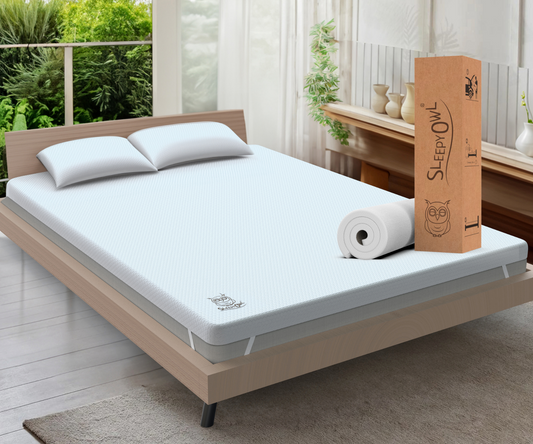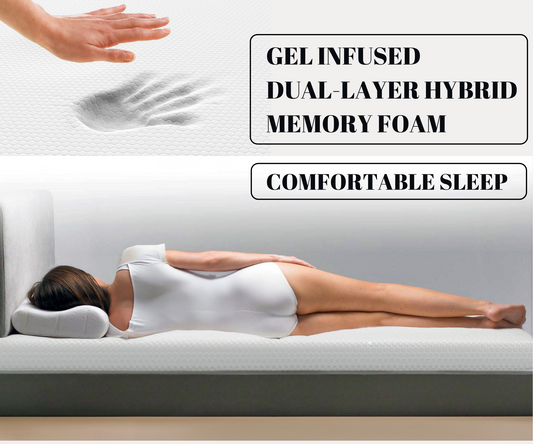Ultimate Guide to Memory Foam Mattress
Memory foam mattresses have revolutionised the way we think about sleep. Originally developed by NASA in the 1960s to improve seat cushioning for astronauts, this innovative material has since found its way into homes around the world. The unique properties of memory foam allow it to contour to the body, providing personalised support and comfort.
As more people seek better sleep solutions, memory foam mattresses have gained popularity for their ability to alleviate pressure points and enhance overall sleep quality. In recent years, the market has seen a surge in various types of memory foam mattresses, catering to different preferences and needs. From budget-friendly options to luxury models, there is a memory foam mattress for everyone.
Understanding the benefits and features of these mattresses can help you make an informed decision when it comes to investing in your sleep. I recently purchased a new memory foam mattress topper for my bed.
Benefits of Memory Foam Mattress
Improved Sleep Quality
As a result, many users report experiencing less discomfort and improved spinal alignment during sleep.
Motion Isolation
Another significant advantage is the motion isolation feature of memory foam. If you share your bed with a partner, you may have experienced disturbances from their movements during the night. Memory foam mattresses absorb motion, meaning that when one person shifts or gets up, the other remains undisturbed.
Ideal for Couples
This quality makes memory foam an excellent choice for couples seeking a peaceful night’s sleep.
Choosing the Right Memory Foam Mattress for You
Selecting the perfect memory foam mattress involves considering several factors tailored to your individual needs. First and foremost, assess your preferred firmness level. Memory foam mattresses come in various firmness options, ranging from soft to firm.
A softer mattress may be ideal for side sleepers who require extra cushioning for their shoulders and hips, while back and stomach sleepers might benefit from a firmer surface that supports proper spinal alignment. Additionally, consider the thickness of the mattress. Thicker mattresses often provide more support and durability, while thinner options may be more suitable for those who prefer a lower profile.
It’s also essential to take into account your sleeping position, body weight, and any specific health concerns, such as back pain or allergies. By evaluating these factors, you can find a memory foam mattress that meets your unique requirements.
Understanding Memory Foam Technology
| Aspect | Explanation |
|---|---|
| Density | The measure of how much a cubic foot of memory foam weighs, typically ranging from 2.5 to 5 pounds per cubic foot. |
| Indentation Load Deflection (ILD) | The measure of how much force is required to indent the foam, indicating its firmness. |
| Temperature Sensitivity | The ability of memory foam to soften in response to body heat, allowing it to mould to the body's shape. |
| Resilience | The ability of memory foam to return to its original shape after pressure is removed. |
| Off-Gassing | The release of chemical odours when memory foam is first unpackaged, which can dissipate over time. |
Memory foam technology has evolved significantly since its inception. Modern memory foam mattresses often incorporate advanced materials and manufacturing techniques to enhance performance. For instance, many brands now offer gel-infused memory foam, which helps regulate temperature by dissipating heat.
This feature addresses one of the common complaints associated with traditional memory foam: its tendency to retain heat. Furthermore, some manufacturers utilise open-cell technology to improve breathability and airflow within the mattress. This innovation allows for better temperature regulation and reduces the likelihood of overheating during sleep.
Understanding these technological advancements can help you choose a memory foam mattress that not only provides comfort but also promotes a cooler sleeping environment.
Memory Foam Mattress Care and Maintenance
Proper care and maintenance are crucial for extending the lifespan of your memory foam mattress. Regularly rotating your mattress can help prevent uneven wear and prolong its durability. It is generally recommended to rotate your mattress every three to six months, depending on usage.
Additionally, using a mattress protector can safeguard against spills, stains, and allergens, ensuring that your investment remains in excellent condition. Cleaning your memory foam mattress is also essential for maintaining hygiene. Most manufacturers recommend spot cleaning with mild soap and water for any stains or spills.
Avoid using harsh chemicals or soaking the mattress, as this can damage the foam. Regularly airing out your mattress can help eliminate odours and moisture, contributing to a fresher sleeping environment.
Comparing Memory Foam Mattresses to Other Types
When considering a new mattress, it’s essential to compare memory foam with other popular types, such as innerspring and latex mattresses. Innerspring mattresses are known for their bounce and support due to their coil systems; however, they may not provide the same level of contouring as memory foam. This difference can lead to pressure points for some sleepers, particularly those who prefer side sleeping.
Latex mattresses offer a different feel altogether, providing a more responsive surface that bounces back quickly when pressure is removed. While latex can be more breathable than traditional memory foam, it may not contour as closely to the body. Ultimately, the choice between these types depends on personal preference and specific sleep needs.
Memory Foam Mattress Myths Debunked
Despite their popularity, several myths surrounding memory foam mattresses persist. One common misconception is that all memory foam mattresses are hot to sleep on. While traditional memory foam can retain heat, many modern options incorporate cooling technologies such as gel infusion or open-cell structures that promote airflow.
These advancements have significantly improved temperature regulation in memory foam mattresses. Another myth is that memory foam mattresses are too soft and lack support. In reality, there are various firmness levels available in memory foam mattresses designed to cater to different sleeping styles and preferences.
Many people find that a medium-firm option provides an ideal balance of comfort and support, making it suitable for a wide range of sleepers.
How to Extend the Lifespan of Your Memory Foam Mattress
To ensure your memory foam mattress lasts as long as possible, consider implementing a few simple practices. First, invest in a high-quality mattress protector that fits snugly over your mattress. This barrier will protect against spills, dust mites, and allergens while also preventing wear from regular use.
Additionally, avoid jumping or putting excessive weight on your mattress, as this can cause damage over time. When moving or adjusting your mattress, lift it rather than dragging it across surfaces to prevent tearing or bending. By following these guidelines, you can significantly extend the lifespan of your memory foam mattress.
Tips for Getting the Best Sleep on a Memory Foam Mattress
To maximise your sleep experience on a memory foam mattress, consider establishing a consistent bedtime routine that promotes relaxation. Engaging in calming activities such as reading or meditating before bed can help signal your body that it’s time to wind down. Additionally, maintaining a comfortable room temperature can enhance your sleep quality; aim for a cool environment that encourages restful slumber.
Experimenting with different pillow types can also improve your overall comfort while sleeping on a memory foam mattress. A supportive pillow that aligns with your sleeping position can help maintain proper spinal alignment and reduce neck pain. By making these adjustments, you can create an optimal sleep environment tailored to your needs.
Memory Foam Mattress Accessories and Add-Ons
Enhancing your sleep experience with accessories designed for memory foam mattresses can make a significant difference in comfort and support. Consider investing in high-quality sheets made from breathable materials such as cotton or bamboo; these fabrics promote airflow and help regulate temperature during sleep. Additionally, adjustable bed bases can provide added versatility by allowing you to customise your sleeping position for optimal comfort.
Whether you prefer reading in bed or elevating your legs for better circulation, an adjustable base can enhance your overall sleep experience.
Is a Memory Foam Mattress Right for You?
In conclusion, a memory foam mattress offers numerous benefits that cater to various sleep preferences and needs. With their ability to provide personalised support, motion isolation, and pressure relief, they have become a popular choice among sleepers worldwide. However, it’s essential to consider factors such as firmness level, thickness, and individual sleeping habits when selecting the right mattress for you.
If you’re seeking improved sleep quality and comfort, investing in a memory foam mattress could be an excellent decision. Take the time to explore different options available on the market and consider how they align with your specific requirements. With the right choice, you can enjoy restful nights and wake up feeling rejuvenated each day.
FAQ Section 1. How long does a memory foam mattress last?
- A high-quality memory foam mattress typically lasts between 7 to 10 years with proper care. 2.
Are memory foam mattresses suitable for all sleeping positions?
- Yes! There are various firmness levels available that cater to different sleeping positions such as side, back, and stomach sleepers. 3.
Do I need a special bed frame for a memory foam mattress?
- While not mandatory, using a solid foundation or adjustable base can enhance support and prolong the lifespan of your mattress. 4. Can I use my existing bedding with a memory foam mattress?
- Yes!
Most standard bedding fits well on memory foam mattresses; however, ensure that sheets are made from breathable materials for optimal comfort. 5. How do I clean my memory foam mattress?
- Spot clean with mild soap and water for stains; avoid soaking the mattress or using harsh chemicals that could damage the foam.
FAQs
What is a memory foam mattress?
A memory foam mattress is a type of mattress that is made from a viscoelastic material. It is designed to contour to the shape of the body, providing support and comfort.
How does a memory foam mattress work?
Memory foam mattresses respond to heat and pressure, allowing them to mould to the shape of the body. This helps to distribute weight evenly and alleviate pressure points, resulting in a more comfortable and supportive sleep surface.
What are the benefits of a memory foam mattress?
Memory foam mattresses are known for their ability to provide excellent support and comfort. They can help to relieve aches and pains, improve sleep quality, and reduce motion transfer, making them a popular choice for many people.
Are there any drawbacks to memory foam mattresses?
Some people may find that memory foam mattresses retain heat, which can make them feel too warm during the night. Additionally, memory foam mattresses can be quite heavy and may have a slight initial odour when first unpacked.
How long do memory foam mattresses last?
The lifespan of a memory foam mattress can vary depending on factors such as usage and care. On average, a high-quality memory foam mattress can last between 8-10 years.
Are memory foam mattresses suitable for everyone?
While memory foam mattresses can provide excellent support and comfort for many people, they may not be suitable for everyone. Those who prefer a firmer or cooler sleeping surface may not find memory foam mattresses to be the best option for them.


